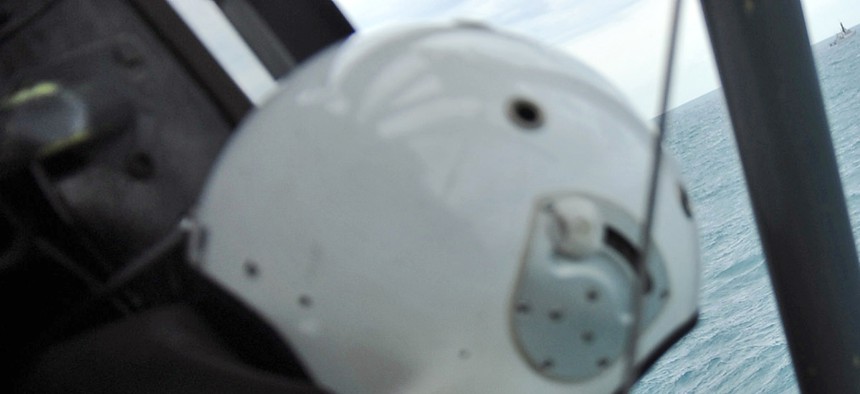
In this photo taken from an Indonesian Air Force Super Puma helicopter Saturday, Jan. 10, 2015, portion of the tail of AirAsia Flight 8501 is seen on the deck of a rescue ship after it was recovered from the sea floor on the Java Sea. AP / PRASETYO UTOMO, POOL
The Technology That Just Found the Missing AirAsia Plane
This is how rescue crews found a missing plane on the ocean floor. By Patrick Tucker
Last week, authorities in Indonesia confirmed that rescue crews had located the tail from AirAsia flight QZ8501. Grainy images of the submerged plane soon appeared on Australian and then American television. The black boxes were quickly recovered. But how were they found?
The pictures that have emerged from early media reports -- green monochrome images of the missing plane -- come from what’s called side scan sonar . Whereas radar uses electrical pulses to locate objects, sonar sends sound pulses that reflect off of objects like submarines or the sea floor to provide the operator with a picture based on acoustic reflection.
At very low frequencies, in the 300 to 900 khz (kilohertz), range, sonar can send sound waves out to cover wide areas. At higher frequencies, 600 to 1800 khz, the sound waves create incredibly detailed pictures of the objects that they encounter.
The specific sonar system that the United States military is using in its effort to help the search, in part by ruling out areas where wreckage is not, is the Sea Scan HDS, manufactured by a Virginia-based company called Marine Sonic , recently acquired by Atlas North America. Police departments around the world use it to hunt for evidence that people throw into bodies of water.
The Navy’s Mobile Diving and Salvage Unit (MDSU 1) out of Pearl Harbor, Hawaii, uses Sea Scan as part of their missions, including in the missing AirAsia search. The USS Fort Worth, one of the ships that the United States deployed in the search for the missing plane, has the device onboard (in a towed array format.) The Australian naval vessels involved in the search also have it.
It’s an ocean scavenging technology that shares a close relationship with a different sort of device that’s in hospitals and clinics around the world. That's particularly evident in Marine Sonic's backstory.
Marine Sonic Technologies was the brainchild of a fellow named Martin Wilcox , an electrical engineer who earned his Bachelor of Science from the University of Pennsylvania in 1966. Wilcox worked for many years in the field of applying sound scanners to medical diagnosis, what’s called ultrasonics, derived from the Latin world “ultra,” or beyond, and “sonic,” which refers to acoustics or sound.
We know ultrasonic technology by the more common term, ultrasound.
In the 1970s, the way that ultrasound worked is this: electric current would pass through quartz crystals, which caused those crystals to change shape, which in turn caused high-pitched sound vibrations that could pass through soft tissue and then bounce back when they encountered harder objects. It’s those vibrations that made up the moving sound pictures of a fetus’s beating heart.
In 1972, Wilcox and his business partner, Edward Diethrich, formed a company called Advanced Diagnostic Research, ADR, to leverage technological advances they were seeing in the field of ultrasonics. In 1973, he filed a patent for a device that used 64 crystals to make a sonic picture where other models used around 21. In 1975, he took the device to market where it became a blockbuster.
The ADR device was able to send a lot more sound pulses into abdominal tissue. The picture it displayed was clearer and the device was also smaller than its counterparts. The advantages of what came to be called portable ultrasound over larger machines are immediately obvious. A portable ultrasound could be moved from hospital room to hospital room, allowing expectant mothers to view the fetus’s beating heart from the bedside.
In 1982, when Wilcox and Diethrich sold the company to Squibb, Wilcox agreed to a non-compete clause that kept him out of the medical device market for years. He was on a fishing expedition using ultrasound to find fish (clearly bored with just waiting for them to bite) when he first decided to turn his attention to innovating side-scanning sonar, a technology that the United States and other countries had been using for decades.
That’s how the same technology that has helped millions of doctors bring children into this world is helping put to rest the search for missing AirAsia flight QZ8501.
NEXT STORY: DISA Reshuffle Shines a Spotlight on Cyber





